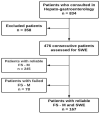Fibroscan® and Shear Wave correlated well in hepatic fibrosis evaluation of patients with chronic liver diseases "in real life situation"
- PMID: 35960072
- PMCID: PMC9371580
- DOI: 10.1097/MD.0000000000030025
Fibroscan® and Shear Wave correlated well in hepatic fibrosis evaluation of patients with chronic liver diseases "in real life situation"
Abstract
Background: A new noninvasive medical device based on ultrasound elastography such as the Shear Wave Elastography (SWE) was designed in order to measure the liver hardness. The purpose of this work was to evaluate the correlation of the results of the liver elasticity measurements obtained by Fibroscan® (FS) and SWE for patients with chronic liver diseases.
Methods: Between January and October 2017, the patients who were followed during this period of time underwent noninvasive assessments of liver fibrosis by SWE in the intercostal spaces during abdominal ultrasound procedures and/or FS. The correlation between FS and SWE was estimated and tested at a 0.05 significance level.
Results: Four hundred and seventy-six patients were included in this study. The main etiologies of chronic liver disease were non alcoholic fatty disease (NAFLD), chronic viral hepatitis B (HBV) and chronic viral hepatitis C (HCV). All patients underwent a SWE and 167 among them underwent a FS procedure. The patients who were followed revealed a median FS measurement of 5.80 kpa (Q25 = 4.90 kPa; Q75 = 8 kPa) and a median SWE measurement of 7.00 kPa (Q25 = 6.10 kPa; Q75 = 8.10 kPa). We could observe a significant correlation between the FS and SWE measurements (0.49; P = .001) in the total cohort. The average absolute difference between the measurements of these 2 methods was of 2.54 kPa (sd = 3.39). There was no significant correlation for patients with NAFLD no matter whether they presented with signs of suspected non alcoholic steatohepatitis (NASH) or not (R = 0.20; P = .108). All patients intending to perform the examination were able to undergo the SWE, allowing 33.3% of the patients who failed the FS to have a noninvasive evaluation of their fibrosis.
Conclusion: The SWE technique proved to be as efficient as the FS one for the evaluation of the liver fibrosis in real life situation.
Copyright © 2022 the Author(s). Published by Wolters Kluwer Health, Inc.
Conflict of interest statement
The authors have no funding and conflicts of interest to disclose.
Figures






Similar articles
-
Liver fibrosis: noninvasive assessment using supersonic shear imaging and FIB4 index in patients with non-alcoholic fatty liver disease.J Med Ultrason (2001). 2018 Apr;45(2):243-249. doi: 10.1007/s10396-017-0840-3. Epub 2017 Nov 11. J Med Ultrason (2001). 2018. PMID: 29128938
-
Ultrasound Shear Wave Elastography for Liver Disease. A Critical Appraisal of the Many Actors on the Stage.Ultraschall Med. 2016 Feb;37(1):1-5. doi: 10.1055/s-0035-1567037. Epub 2016 Feb 12. Ultraschall Med. 2016. PMID: 26871407
-
Comparing 2D-shear wave to transient elastography for the evaluation of liver fibrosis in nonalcoholic fatty liver disease.Eur J Gastroenterol Hepatol. 2022 Sep 1;34(9):961-966. doi: 10.1097/MEG.0000000000002412. Epub 2022 Jul 19. Eur J Gastroenterol Hepatol. 2022. PMID: 35913779
-
Assessment of biopsy-proven liver fibrosis by two-dimensional shear wave elastography: An individual patient data-based meta-analysis.Hepatology. 2018 Jan;67(1):260-272. doi: 10.1002/hep.29179. Epub 2017 Nov 15. Hepatology. 2018. PMID: 28370257 Free PMC article. Review.
-
Two-dimensional shear wave elastography for significant liver fibrosis in patients with chronic hepatitis B: A systematic review and meta-analysis.Eur J Radiol. 2020 Mar;124:108839. doi: 10.1016/j.ejrad.2020.108839. Epub 2020 Jan 17. Eur J Radiol. 2020. PMID: 31981878
Cited by
-
Comparative analysis of vibration-controlled transient elastography and EUS-shear wave elastography for liver stiffness measurement in cirrhosis.Endosc Ultrasound. 2025 Mar-Apr;14(2):57-64. doi: 10.1097/eus.0000000000000114. Epub 2025 May 5. Endosc Ultrasound. 2025. PMID: 40385964 Free PMC article.
-
Frequency of fibrosis in patients with incidentally detected hepatosteatosis.Rev Assoc Med Bras (1992). 2023 Dec 18;70(1):e20230984. doi: 10.1590/1806-9282.20230984. eCollection 2023. Rev Assoc Med Bras (1992). 2023. PMID: 38126451 Free PMC article.
-
Modern ultrasound techniques for diagnosing liver steatosis and fibrosis: A systematic review with a focus on biopsy comparison.World J Hepatol. 2025 Feb 27;17(2):100033. doi: 10.4254/wjh.v17.i2.100033. World J Hepatol. 2025. PMID: 40027573 Free PMC article.
References
-
- European Association for the Study of the Liver. EASL Clinical Practice Guidelines: management of hepatitis C virus infection. J Hepatol. 2011;55:245–64. - PubMed
-
- Cadranel J-F, Rufat P, Degos F. Practices of liver biopsy in France: result of a prospective nationwide survey. Hepatology. 2000;32:477–81. - PubMed
-
- European Association for the Study of the Liver. EASL Clinical Practice Guidelines on non-invasive tests for evaluation of liver disease severity and prognosis. J Hepatol. 2021;75:659–89. - PubMed
-
- Huet N, Denis I, Martino A, et al. . Ultrasonographic assessment of liver fibrosis with computer-assisted analysis of liver surface irregularities. Diagn Interv Imaging. 2015;96:941–6. - PubMed
MeSH terms
LinkOut - more resources
Full Text Sources
Medical

